STEPHEN GILLANDERS REMEMBERS THE MOMENT when he saw the power Rich Melman wields as chairman of Lettuce Entertain You. Gillanders, a former corporate chef for Jean-Georges Vongerichten in New York and Las Vegas, whose main previous experience in Chicago had been a couple of multiweek stints opening Vongerichten’s version of The Pump Room in the Public Hotel (née Ambassador East), was working on his own concept in Los Angeles, called S.K.Y. One thing he was learning was that it was hard to get out from under a celebrity chef’s name and establish his own identity as a chef in a new city.
“A friend of mine said to me, there’s this thing in Chicago called Intro, it’d be a good place to work on your dishes and try them out,” he says. So he contacted Melman and was immediately invited to do a tasting. “I had about twenty dishes worked out for S.K.Y. And they said, bring your best. If it’s seven dishes, do seven dishes. If you have three great dishes, do three. If you don’t think dessert is strong, don’t do dessert.”
He did a five-course tasting, it seemed to go well, and he was talking with Melman about his background. Gillanders is part Filipino and his wife is Korean, “so I told him that I had been all over Asia with Jean-Georges opening restaurants. And a lot of that was reflected in what I cook—some of the best meals I’d had were in Tokyo or Shanghai. But I hadn’t really gone to Europe—at that time Jean-Georges would take his family on the Paris trips, so I was never part of that. Rich looks at me and says, well, you have to go to Europe if you’re a chef.”
“I explained that we were saving our money for the restaurant and a trip to Europe wasn’t in the family budget. At that point, he basically whips out the checkbook and writes me a check to go to Europe with my wife for ten weeks and eat wherever we thought we should go. I’ve known the guy for all of eleven minutes, and he’s sending me to Europe to eat.”
Gillanders and his wife took the assignment seriously. “We decided we should eat three meals a day, and at dinner, always order wine, and always order dessert. Wine was optional at lunch, but breakfast couldn’t be an Egg McMuffin, we had to go get a pain au chocolat or something.”
“Fourteen pounds later,” as Gillanders puts it, did it pay off for Lettuce? “Before, I was pretty much an Asian chef, even—although I hate to the use the word—a fusion one. And I think it really rounded out how I cook, and you can see that at Intro now,” he explains.
ANOTHER POWER RICH MELMAN HAS is to take a concept that’s not quite living up to its potential and rework it—as he did at the beginning of February by making Gillanders, Intro Chicago’s fourth guest chef, into the restaurant’s permanent executive chef. The restaurant had gotten good press, it had been nominated for a Jean Banchet Award for best restaurant and it was the only place Phil Vettel reviewed more often in the Tribune than Next (four times a year, with each guest chef)—but it wasn’t drawing the regular neighborhood traffic it needed to survive. “People would eat here and say ‘That was great, see you in three months when the next chef comes,'” Gillanders says.
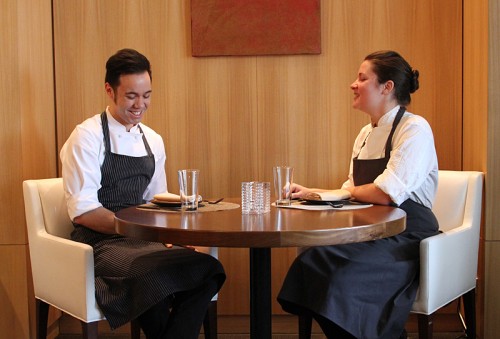
Intro executive chef Stephen Gillanders, and current guest chef Jessica Largey
So the initial plan was to scrap the tasting menu format and become an a la carte restaurant with a guest chef adding his or her dishes to the menu. With his operational background and experience launching restaurants, Gillanders seems a logical choice to make sure Intro ran consistently. And moving Intro away from the strict tasting menu format also gibes with Gillanders’ own ideas—his plans for S.K.Y. were always a la carte, and he seems well-suited to the job of melding Intro’s guest chef concept with a menu that’s more accommodating to everyday dining in Lincoln Park (and particularly to residents in the Belden-Stratford apartment building, where Intro occupies the former L2O space).
The hitch was that that change in concept happened right as Jessica Largey was coming in as Intro’s fifth guest chef. Largey, who won the 2015 James Beard Foundation Award for Rising Star Chef, worked at Manresa, the acclaimed three Michelin star restaurant in San Francisco, for six years. And like Gillanders, she came to Intro with the idea of refining her ideas for her own future restaurant. Now she and Gillanders have had to negotiate the new way that Intro would work, so that their collaboration still showcases the visiting chef’s food—and keeps Intro an enticing enough opportunity to attract future ones.
One way they’re doing that is that just a few weeks after announcing the tasting menu was gone, they’re bringing it back—as an option, if no longer as the sole focus of the restaurant. Largey’s vegetable-driven tasting menu—especially impressive coming in winter—debuted last Friday; I spoke with her and Gillanders that afternoon, and she also comments on some of her dishes in the slideshow below.
FOODITOR: So Jessica, you’re from California, and Stephen, you’re from New York. Did you think about what you were getting into coming to Chicago for a gig at this time of the year?
JESSICA LARGEY: I’ve never lived through winter, so it has been kind of fun—I get to wear winter clothes, and go outside and be like, huhhh! [She imitates a Chicagoan stepping outside.] It’s nice, though it’s really hard to get produce, which is something I’m not used to. But otherwise, it’s been nice, I wish we had more seasons in California—I’m flying there next week for some meetings and it’s 80 degrees—and I was thinking, I don’t even have clothes with me to bring to wear there, because I only brought winter clothes.
It was just the time frame that they presented to me, and when I thought about it I thought, well that will be really fun—to go and live through a winter and to have all these challenges. There’s been a few things where we got in some produce and they just really didn’t taste like anything, so I was like—okay, well, we’ll do something else and reformat the dish to kind of fit that. They’re pretty resourceful here with finding stuff, so the sous chefs and Stephen and everybody’s been really great about helping me source the things that I’m looking for.
I developed kind of a new relationship with food. I woke up early in the morning and made breakfast. Which is something cooks don’t do.
STEPHEN GILLANDERS: My first foray into Chicago was almost six years ago, when we reopened The Pump Room—that was my first opening as an executive chef for Jean-Georges and his corporation. It was the first time I was able to come to Chicago and enjoy it. But there’s a thing about dining out with Jean-Georges, every restaurant you go to knows you’re there and the chef is coming out and everything is taken care of and made perfect for you. And so you don’t know what a restaurant really is, because he’s there. You get the full VIP treatment.
So we had some spectacular meals and some impressive showings. But what I really liked about Chicago was that after he left, and I would have meals out by myself, and I was finding that the restaurants in Chicago were still operating at the same level. I like to say that Brooklyn’s chasing what Chicago has established, in terms of the kind of cooking that they do. I feel like there’s more honest cooking. I feel like chefs are actually doing what they want.
But then when I came back in February—it was no longer the beginning of the fall, it was freezing outside. Thankfully I didn’t come straight back from Los Angeles to Chicago, which would have been very difficult. I’d already been in New York for a little while, so I saw some snow. But I was out here for another seven weeks [at The Pump Room]. I think Chicago is like a combination of Los Angeles and New York, two cities that I spent a lot of time in, and some of the meals I’ve had here, some of the restaurants I’ve been in here, are just some of the best I’ve been to in general. Six years ago I wouldn’t have thought I’d end up here, but… here we are.
Gallery: Jessica Largey’s dishes at Intro Chicago
Photos by Anjali Pinto
Jessica: Coming here in winter is a good challenge. I’m too spoiled I think sometimes, there’s peas in California, and there won’t be peas here until May, so I’ll miss them in both places. But it’s nice to have the challenge of, you can’t get this or you have to wait for that. To rethink it, or to think, what can we do with celery root instead of that. Or, we have apples, let’s do something cool with apples. They’re vegetables I love, and normally we use them for a month at home. So to create something around it has been fun.
Jessica, tell me about the philosophy behind the place you hope to open after being at Intro.
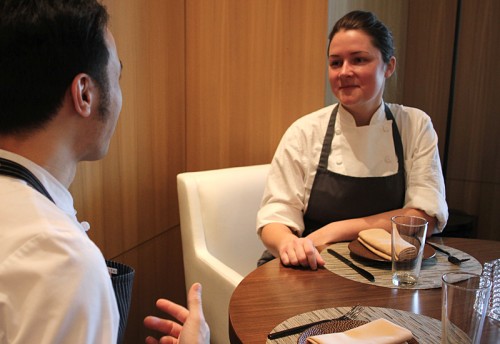
I took the last eight months off, and spent a lot of time traveling and with friends and family, and really just decompressing from working for the last eleven years non-stop. So I really developed kind of a new relationship with food. I cooked a lot for friends at their houses and had dinner parties and cooked for myself everyday. Woke up early in the morning and made breakfast. Which is something cooks don’t do—we don’t eat until like one, maybe.
So it’s been really fun to shift that whole philosophy, and I started to really challenge myself to think about what I do want to build and what kind of business I do want to have. One of the appeals of coming here is to be able to get back into a kitchen, and help myself to get back into that mindset and finish formulating those ideas. But I definitely want to build a place that I would go to all the time, and build a place that is more casual and approachable than fine dining, but I want to still be in that realm, too. Because I do really love it.
I know your Intro dishes have a strong vegetable focus—are they all vegetarian?
No. I really love vegetables, and I want to focus on them, but the dishes aren’t all vegetarian even if they’re vegetable based. One of them, the romanesco dish, has an anchovy sauce on it—we have a replacement for vegetarians that’s a yuzu koshu sauce. It’s easy to make it vegan, even. And then I’m also going to be putting on some dishes that are meat-based and seafood-based. But for the tasting menu, we’re focusing on vegetables. It’s more of like a set menu, of five dishes, including a dessert, and those dishes are also available on the a la carte menu. And then there are other dishes on the a la carte menu as well.
Jessica, you came in just as they put Stephen in charge of the overall operation. Did that change your plans for Intro?
It did, and I think it’s still evolving, and we’re still navigating our way through that. But it’s exciting that we get to set up a new system for the next set of chefs to come after me. I think it’s great for the staff to have someone here who’s consistent and who they can always go to and reference, and who they’re comfortable with and they have the attachment as an employee to. And then they still get to have the fun of having the new chefs come in and learning new things. But it’s definitely more stable, and more sustainable, I think, in a lot of ways.
When I got here they had just changed to the new format, with the grid. It was also Restaurant Week and they were in the thick of that, so that gave me some time, where it was kind of busy and chaotic, but I also got to see how things were formulated and work in the kitchen, and figure out how to plug my stuff in. So I had a couple of weeks to work those things out. We’re still working on it—it’s going to be a progression for sure.
Stephen: When Jessica came in, I knew how hard it was to come in here, with people you don’t know, because I had just done it. And I knew what my role was now, which was to prevent it from being so hard for Jessica and all the future chefs. Fortunately she’s a very very talented cook, and she has a wide range. She’s also able to manipulate her food, depending on the setting. Whether or not this is exactly what she’s going to be doing in Los Angeles, I couldn’t tell you, but as far as Intro was concerned, she was able to figure out who we’re catering to, and what they’re looking for, and she was able to say, okay, I have this great idea for a mushroom dish.
We have a lot of freedom to do what we want to do and change what we offer. If we have a Sicilian chef in three months who comes in and wants to do gnocchi on the table, then things are going to have to change a little.
So we could take the menu and say, if you have a mushroom dish, and a romanesco dish, and a scallop dish, those dishes are going to cancel out these three dishes. So we literally took a Sharpie and just X’d those three dishes out, penciled hers in, and that’s kind of the way that we’ve been going about it. The nice thing about the menu is we can add, or replace, or remove—we’re not tied into, there’s three courses in column A and three in column B. We have a lot of freedom to do what we want to do, and change what we offer. If we have a Sicilian chef in three months who comes in and wants to do gnocchi on the table, then things are going to have to change a little! But at least with Jessica coming through and being so easy to work with, it’s really made it clear how we’re going to work with other chefs going forward.
How did the change to a la carte come about?
When I first came here, after my trip to Europe, I was trying to piece together how to adapt my S.K.Y. dishes to Intro. And how we were going to fit S.K.Y. into the Intro footprint, because Intro was doing tasting menus at that point. And the general manager, Sue Kim, said why don’t you just do the a la carte menu? And I said, I didn’t know that was even an option. We went from the six-course menu to a 27-item a la carte menu. We only had five days to do it, but the team was just a total bunch of rock stars, we couldn’t have done it otherwise and I wouldn’t have done it if we didn’t have the team that we have, and the support that we have.
But it meant that Intro became a restaurant that people could just come in and have a bite to eat, as opposed to having a fully committed tasting experience. And it provided people the opportunity to come back, as opposed to coming back in three months for the next chef. We had a gentleman and his daughter, who live in the building, come in for a quick bite before a movie, and it was nice to be able to just provide that. As opposed to, what, here’s 4 ounces of fish and a two-ounce pour of wine off the tasting menu, enjoy your dinner.
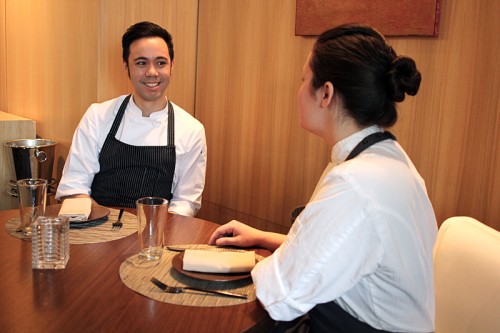
After the holidays there was definite interest in keeping the a la carte format, but it’s very demanding for chefs to bring 27 dishes in right as the restaurant changes over. So I think when they offered me the position as a chef-partner, we weren’t sure how to handle the talent coming through still. Thankfully Jessica’s been incredible, she’s a total pleasure to work with, and very on top of her game. And she was very very fluid with what she wanted to do, how she was going to do it, and how it was going to be applied to the menu.
So she started attacking the menu one column at a time, and her scallop dish was immediately the best-selling item on the menu, and there’s just been a demand from people who want to see her food. As a James Beard award winner, she came with a lot of press, and you know which dishes are hers because they’re color-coded on the menu, and that opens up the servers to talking about her and her food on the menu.
It’s interesting, Jessica, that as you were describing your dishes, you did so in terms of how people dig into it and what they discover. Which is unusual for chefs—I think they typically think of it in terms of a two-dimensional picture on the plate.
Jessica: I learned very early on in my career, when I worked for Michael Cimarusti [Providence in Los Angeles], he would literally pick up a plate and look at it from every single angle. And then he would eat it from different angles. He was always very particular about what you present to the guest, where 90% of the people are going to take that first bite—you want that to be the best part of the fish, the best bite they’re going to have. So they just keep coming back and keep coming back.
And I like thinking about how people are going to eat. Like if you put something in a small bowl, is this going to be easy to spill? Because you don’t want people to spill it. I try to think about what it’s going to be like to eat the dish, and I when I do a new dish, I generally try to eat an entire portion to see if it’s the right amount and how it eats. I like to be considerate of that, because I feel like that’s how people are going to critique it. So you should definitely put yourself in that perspective as the chef.
Jessica, where do you go from here when your time at Intro is up in May?
From here? Well, I’m in the design process of my own project right now, so I’ll be going back to California and working on that. And hopefully we’re going to open at the end of the year. We’re going to release details, probably at the end of my tenure here.
Michael Gebert wields so much power as the editor of Fooditor.
Latest
Join the Discussion
After you comment, click Post. If you're not already logged in you will be asked to log in or register with Disqus.










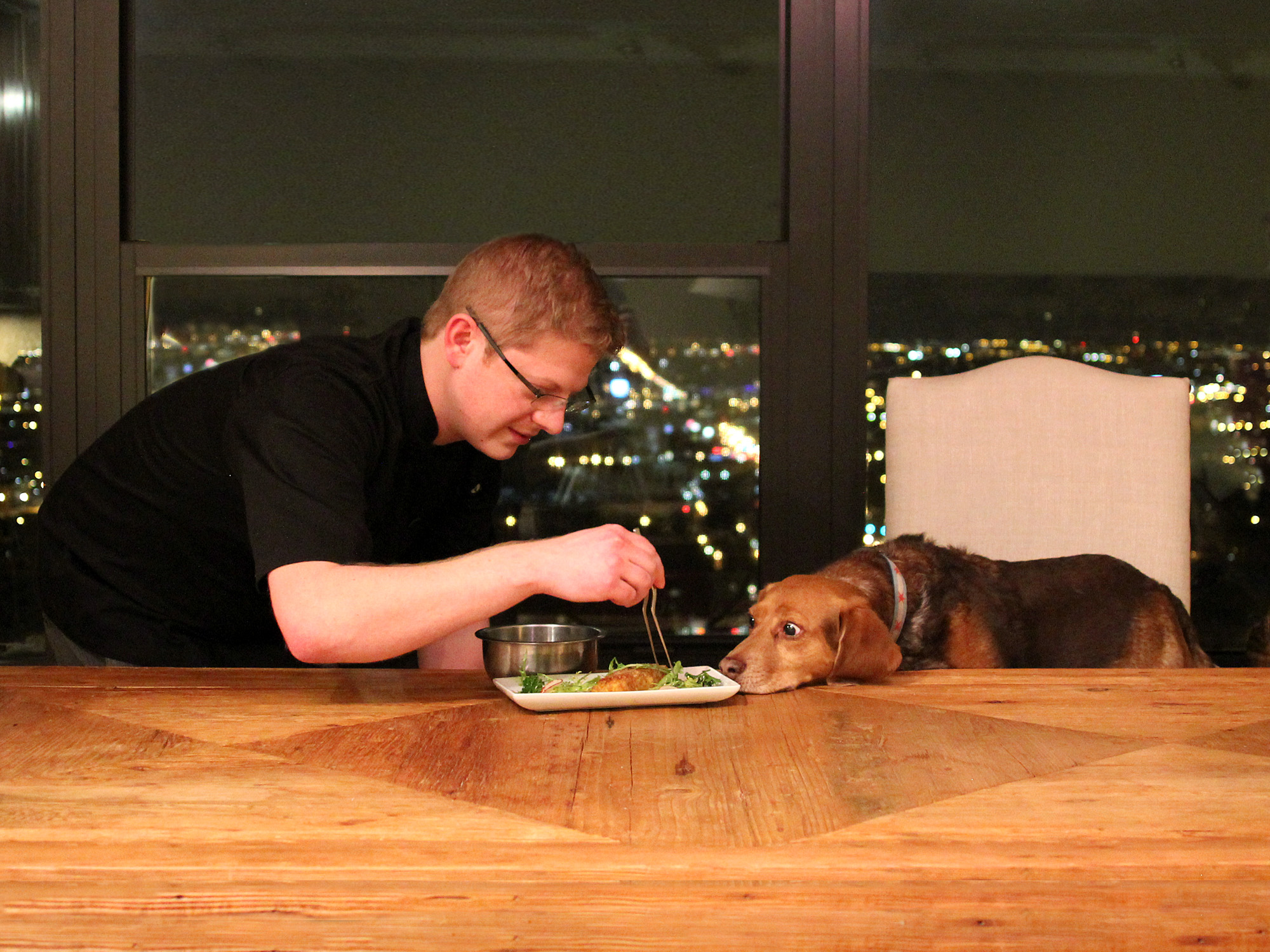

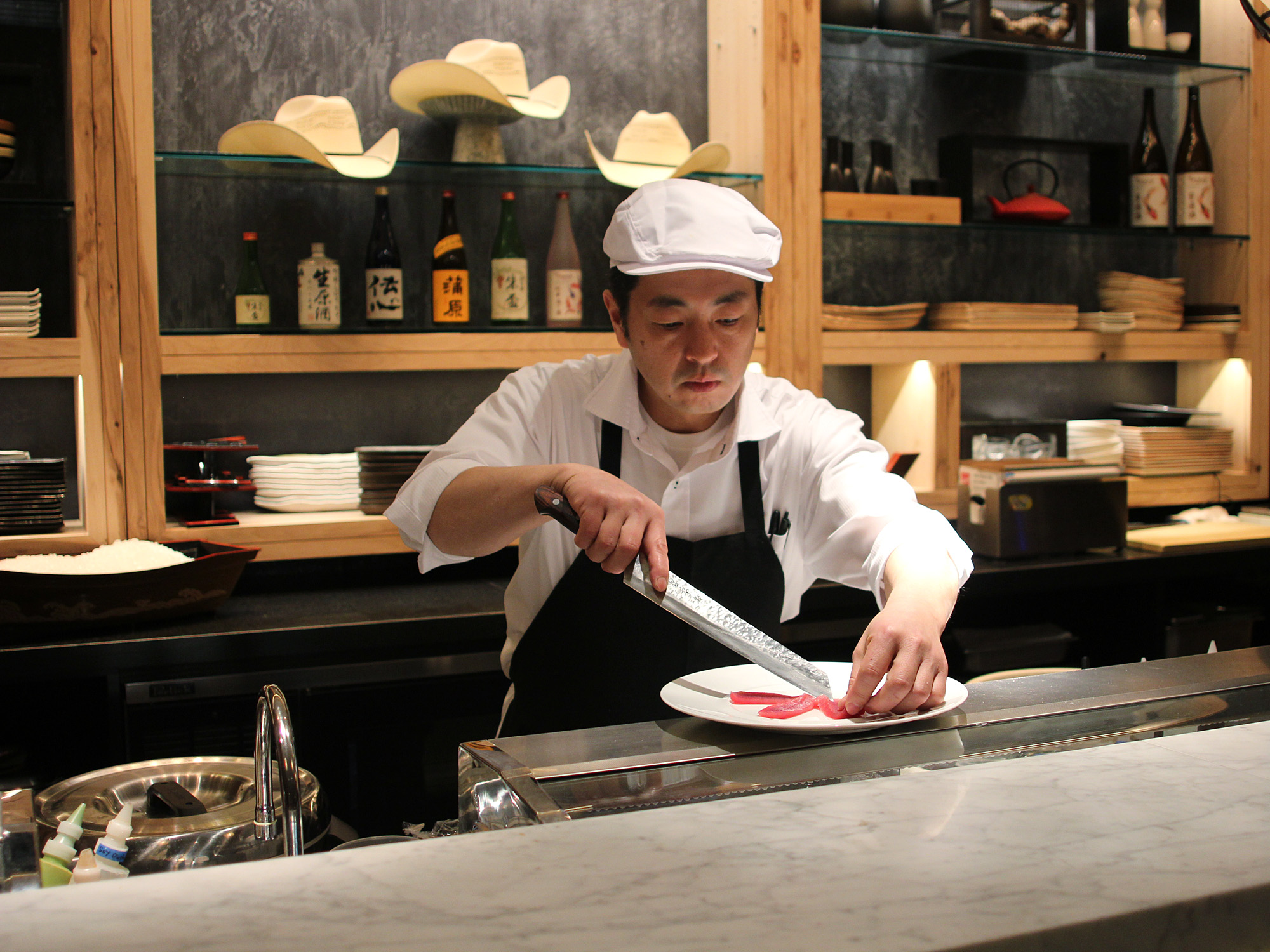
[…] Though as it happens last year’s winner, Jessica Largey, then of Manresa in San Francisco, is the guest chef at Intro right now, too. So it’s a pretty big award here, and this should be a big deal, right? […]